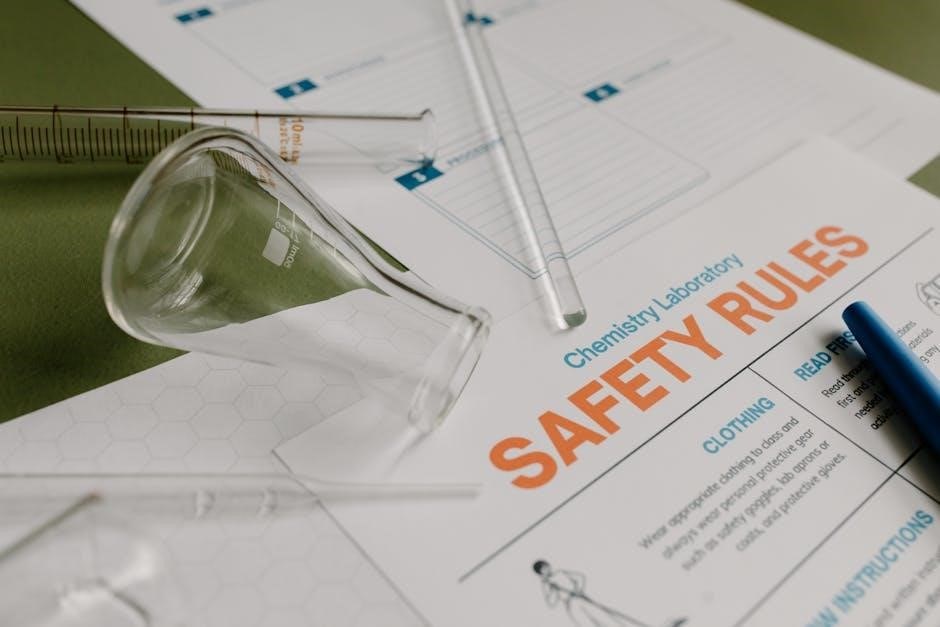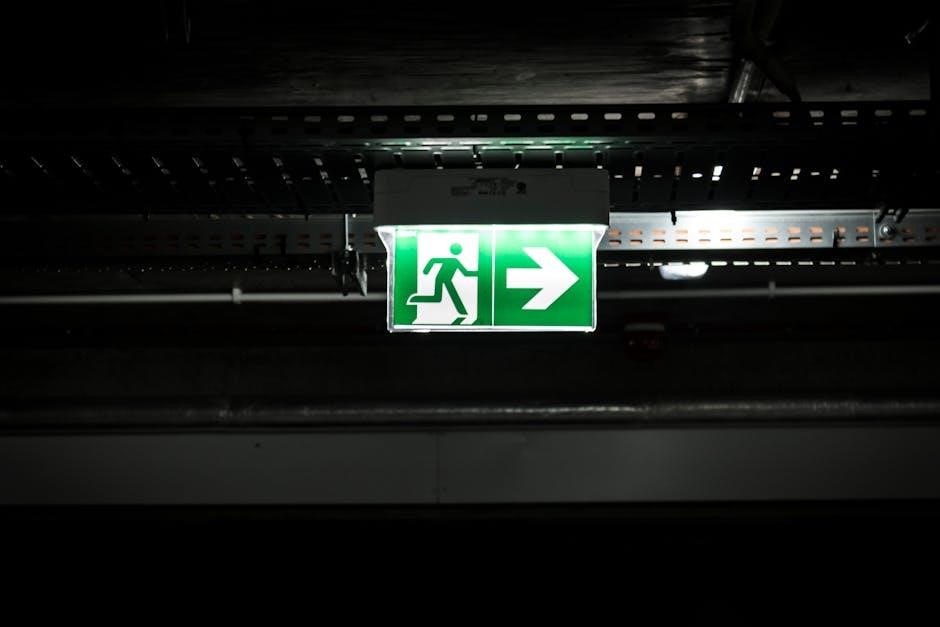The SOS Safety Guide is your ultimate resource for emergency preparedness, detailing modern SOS systems and protocols to ensure safety in critical situations. Stay informed and protected.
Understanding the Importance of Emergency Preparedness
Emergency preparedness is crucial for ensuring safety in unforeseen situations, such as natural disasters, medical crises, or accidents. Being proactive can significantly reduce risks and improve outcomes. Modern SOS systems, like those on iPhones or Garmin devices, offer quick ways to alert authorities or contacts. However, understanding how to use these tools effectively is key. Preparedness also involves having essential safety items, like personal alarms or communication devices, which can be lifesavers. Education and awareness are vital, as they empower individuals to act swiftly and confidently during emergencies. By staying informed and equipped, you can protect yourself and others, ensuring a safer future.
Key Features of Modern SOS Systems
Modern SOS systems are designed to provide rapid assistance in emergency situations. They often include features like GPS tracking, two-way messaging, and automatic alerts to emergency contacts. For instance, the Garmin inReach allows users to send SOS alerts with their exact location, enabling quick response from rescue teams. Similarly, the Pixel Watch’s Emergency SOS can alert both emergency services and predefined contacts. These systems also offer real-time communication, ensuring help is dispatched efficiently. Advanced devices may include battery life optimization and durability for reliability in harsh conditions. Such features make modern SOS systems indispensable for adventurers and individuals seeking enhanced safety measures.

How to Trigger an SOS on Your Device
Triggering an SOS on your device varies by model. iPhones require pressing the side button rapidly or holding it with the volume button. Pixel Watches need swiping and holding the power button. Garmin inReach devices use a dedicated SOS button. Ensure your device is GPS-enabled for accurate location sharing during emergencies. Always test the feature beforehand to understand its operation. This ensures quick activation when needed, providing critical assistance in life-threatening situations. Familiarize yourself with your device’s specific method to act swiftly and confidently during crises. Proper preparation is key to utilizing these safety features effectively. Stay informed and practice regularly for optimal readiness.
Step-by-Step Guide for iPhone Emergency SOS
To activate Emergency SOS on your iPhone, rapidly press the side button five times or press and hold the side button along with one of the volume buttons. This action triggers a countdown and an alert sound. Once the countdown ends, your iPhone automatically calls emergency services. After the call, your device sends your location to your emergency contacts. Ensure Emergency SOS is enabled in Settings under Emergency SOS. For iPhone 8 and later, you can also adjust the Auto Call feature. Always test the feature in a safe environment to understand its operation and ensure it works correctly when needed.
Activating Emergency SOS on Pixel Watch
To activate Emergency SOS on your Pixel Watch, press and hold the side button until the Emergency SOS options appear. Select the Emergency SOS option to send an alert to your emergency contacts or directly contact emergency services. Ensure your emergency contacts are updated in your Google account settings. After triggering, your location is shared with contacts, and a message is sent notifying them of your situation. Always familiarize yourself with the feature in a safe setting to understand its functionality. This feature is designed to provide quick assistance during critical moments, ensuring help is just a button press away.
Using Garmin inReach for SOS Alerts
Garmin inReach devices enable users to send SOS alerts in emergency situations, transmitting your GPS location to emergency responders and designated contacts. To activate, press and hold the SOS button until a confirmation message appears. The device then sends a distress signal via satellite, ensuring help is dispatched promptly; After triggering, remain in your location to facilitate rescue efforts. Garmin inReach also allows two-way messaging, enabling communication with responders and contacts. This feature is vital for adventurers in remote areas with no cellular coverage, providing a reliable lifeline during critical moments. Always ensure your device is fully charged and easily accessible.

What Happens After Sending an SOS
After sending an SOS, emergency services are alerted with your location. Communication begins, and responders are mobilized. Stay in place and follow instructions for a swift rescue.
Emergency Response Protocols
Emergency response protocols are standardized procedures ensuring timely and effective reactions to SOS alerts. When an SOS is triggered, emergency services are immediately notified with your location. Communication channels are established to assess the situation and provide critical instructions. Search and rescue teams are mobilized, and coordination begins with local authorities. Protocols may vary by region but prioritize rapid response and safety. Devices like Garmin inReach and Pixel Watch integrate directly with emergency systems, ensuring accurate location sharing. Response teams are trained to handle diverse scenarios, from medical emergencies to natural disasters, ensuring a structured and efficient rescue process. Preparation is key to effective outcomes;
How Search and Rescue Teams Operate
Search and Rescue (SAR) teams are highly trained professionals who respond to emergencies after an SOS alert is received. Upon activation, teams assess the situation, utilizing advanced tools like GPS data from devices such as Garmin inReach to pinpoint locations. They coordinate with local authorities to deploy resources effectively, whether it’s air, ground, or water-based operations. SAR teams prioritize rapid response and adapt strategies based on the nature of the emergency, such as medical crises or natural disasters. Effective communication and precise execution are critical to ensuring the safety of those in distress; Their expertise and coordination are vital for successful rescues.
Communication with Emergency Contacts
When an SOS alert is triggered, emergency contacts are immediately notified, ensuring quick communication and response. Modern devices like the Pixel Watch and Garmin inReach automatically send alerts to designated contacts, providing critical details such as location and the nature of the emergency. This seamless communication ensures that loved ones or authorities can act swiftly. Additionally, some systems allow for two-way communication, enabling real-time updates and coordination. Effective communication with emergency contacts is vital for resolving crises efficiently and ensuring the safety of individuals in distress. Designating reliable contacts and keeping their information updated is a key part of any safety plan.
Essential Safety Items for Travel
Must-have gadgets include personal alarms, GPS trackers, and emergency apps. These tools enhance safety, providing quick alerts and location sharing in critical situations, ensuring safer adventures worldwide.
Must-Have Gadgets for Personal Safety
Essential safety gadgets include GPS trackers, emergency beacons, and smartwatches with SOS features. Devices like Garmin inReach enable two-way communication and live tracking, while Pixel Watches and iPhones offer Emergency SOS with location sharing. Personal alarms emitting loud sounds can deter threats, and portable power banks ensure devices stay charged. These tools provide real-time assistance, peace of mind, and reliability in emergencies, making them indispensable for travelers and adventurers seeking to stay safe and connected wherever they go.
Best Personal Alarms for Emergency Situations
Personal alarms are vital tools for immediate protection in dangerous situations. Compact and portable, they emit loud, high-decibel sounds to deter attackers and attract attention. Many models feature LED lights for enhanced visibility and multiple activation methods for quick use. Durable designs, including water-resistant options, ensure reliability in various conditions. Long-lasting batteries provide peace of mind, knowing your alarm is ready when needed. Whether for travelers, hikers, or everyday carry, personal alarms are easy to use and effective in emergencies. They are an essential component of a comprehensive safety plan, offering a simple yet powerful way to signal for help in critical moments.
Recommended Travel Safety Gear
When venturing into unfamiliar territories, having the right travel safety gear is crucial. A portable GPS device ensures navigation in remote areas, while a compact first-aid kit handles minor injuries. Water purification tablets or filters provide safe drinking water, essential for hydration. A multi-tool or Swiss Army knife offers versatility for unexpected situations. Durable, weather-resistant luggage protects belongings, and a reliable portable charger keeps devices powered. Additionally, consider packing a lightweight emergency blanket and a whistle for signaling help. These items collectively enhance your ability to stay safe and self-sufficient during travels, ensuring peace of mind in any environment.

Staying Safe in Emergency Situations
Staying safe in emergencies requires preparedness, quick thinking, and adherence to protocols. Assess situations, have a clear escape plan, and use safety gear effectively. Stay calm and follow guidance from authorities to ensure your well-being during crises.
Immediate Actions to Ensure Safety

Immediate actions in emergencies are crucial to prevent situations from escalating. Start by assessing your surroundings to identify potential risks. Secure your environment by moving to a safe location if possible. Activate SOS features on your devices, such as Emergency SOS on iPhone or Pixel Watch, to alert authorities or contacts. Stay visible by using reflective gear or flares if stranded. Maintain open communication with emergency services and follow their instructions carefully. Remember, staying calm and composed will help you make rational decisions. Always prioritize your safety and the safety of others, and avoid actions that could worsen the situation.
Navigating Natural Disasters
Natural disasters like earthquakes, floods, or hurricanes require swift and informed actions. Always have a prepared emergency kit with essentials such as water, food, and a first-aid kit. Stay informed about weather alerts and evacuation routes through reliable sources. If instructed to evacuate, do so promptly and follow designated paths. During the disaster, seek shelter in sturdy structures or safe zones. Afterward, avoid damaged areas and report your status to emergency contacts. Use GPS tracking devices like Garmin inReach to share your location. Stay updated on recovery efforts and follow official guidance to ensure your safety and the safety of others.
Maintaining Mental Health During Crises

Mental health is crucial during crises, as stress and uncertainty can overwhelm. Acknowledge your emotions and prioritize self-care to stay resilient. Staying connected with loved ones provides emotional support and reduces feelings of isolation. Limit exposure to distressing news to avoid overwhelm. Focus on actionable steps within your control, such as following safety protocols or preparing an emergency kit. If needed, seek professional help to cope with anxiety or trauma. Practice mindfulness, deep breathing, or meditation to manage stress. Engaging in routines and helping others can foster a sense of purpose and stability during challenging times.
Empowering individuals to stay safe through preparedness and resilience. This guide equips you with essential tools and knowledge to navigate emergencies confidently. Stay informed, stay proactive, and prioritize safety always.
Final Tips for Enhancing Your Safety
- Stay informed about potential risks and emergency protocols in your area.
- Regularly test your SOS devices to ensure they function properly.
- Share your itinerary with trusted contacts before venturing into remote areas.
- Carry essential safety gear, such as a whistle, flashlight, and first-aid kit.
- Stay mentally prepared to act calmly and decisively during emergencies.
- Participate in safety drills to build confidence and readiness.
These tips will help you stay proactive and secure in any situation.
Importance of Regular Safety Drills
Regular safety drills are essential for preparing individuals and organizations to respond effectively during emergencies. These exercises identify weaknesses in safety protocols and allow for timely improvements. By conducting drills, participants become familiar with emergency procedures, leading to faster response times and better decision-making under pressure. Drills also enhance communication and coordination among team members, ensuring a unified approach during crises. Additionally, they provide an opportunity to test equipment and strategies, ensuring everything functions as intended. For families and organizations alike, regular drills foster a proactive approach to safety, minimizing risks and potential consequences in real-life emergency situations. They are vital for building resilience and saving lives.
